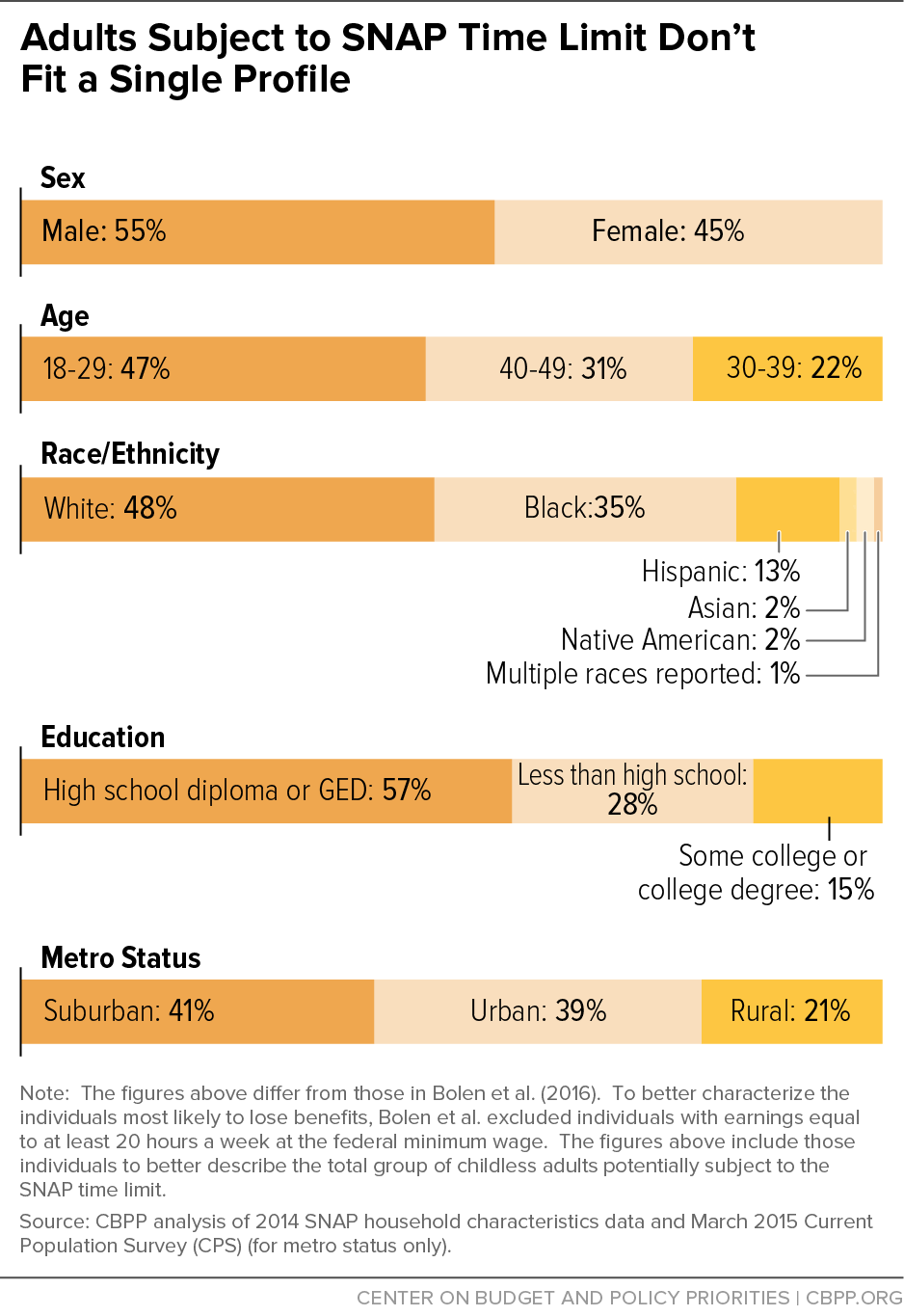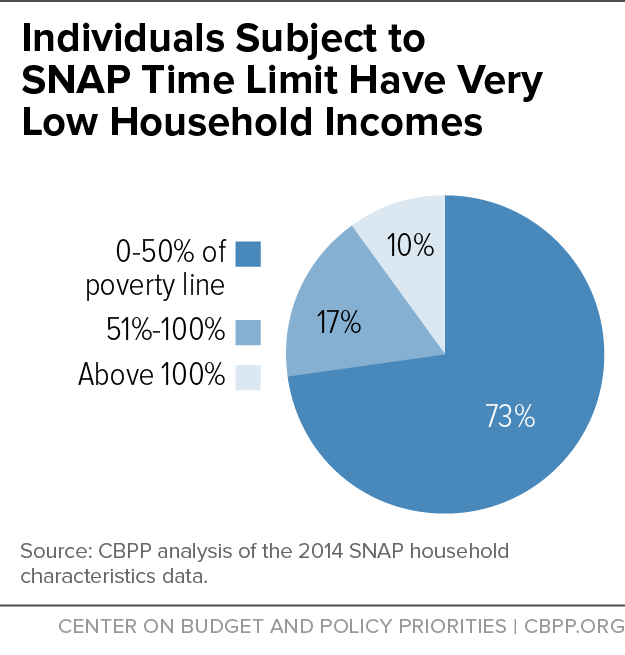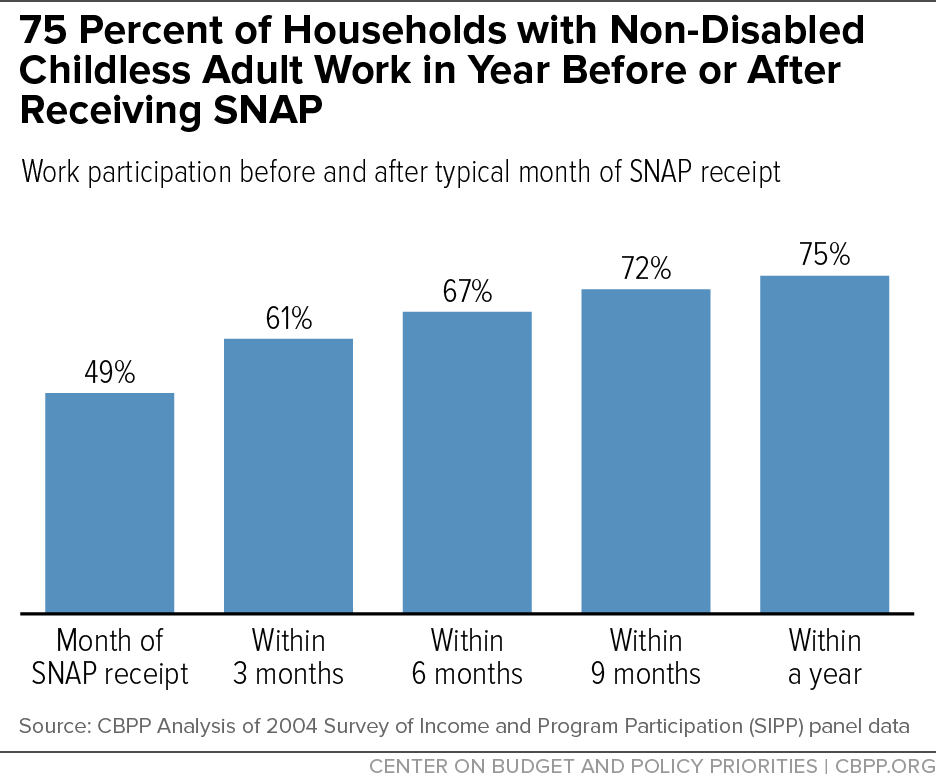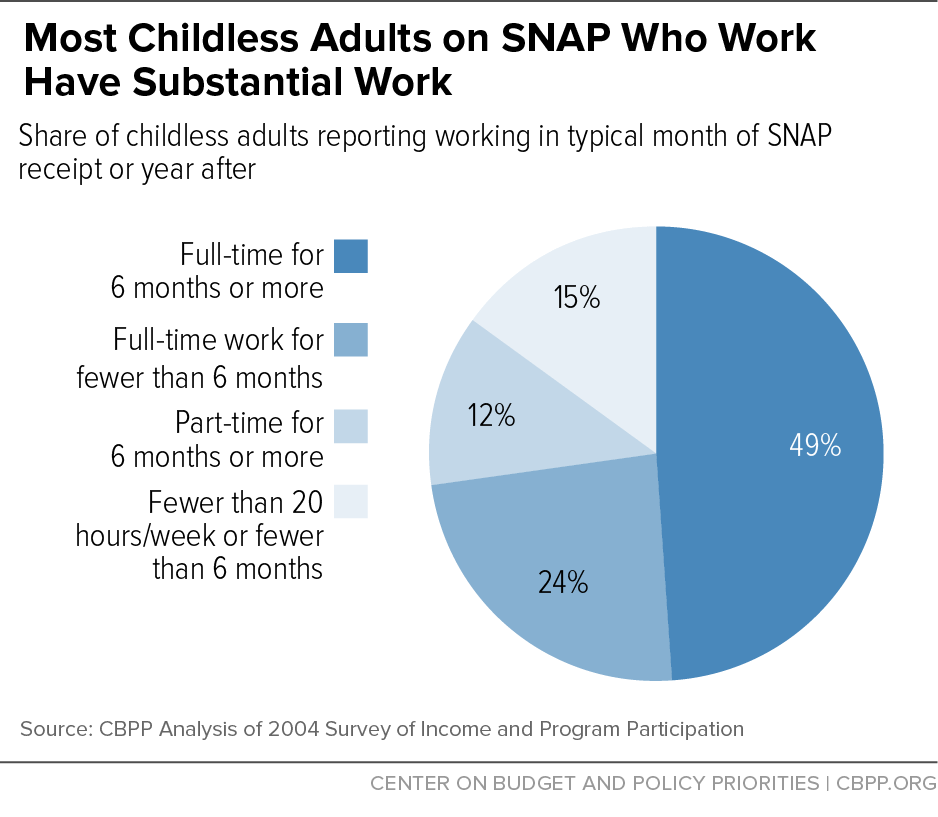Who Are the Low-Income Childless Adults Facing the Loss of SNAP in 2016?
End Notes
[1] Steven Carlson is a research analyst who previously directed the Office of Policy Support at the Agriculture Department’s Food and Nutrition Service. The opinions and conclusions expressed in this report are solely those of the authors and should not be construed as representing the views of the Agriculture Department.
[2] For more information on time limits and the impact of expiring waivers, see Ed Bolen et al., “More than 500,000 Adults Will Lose SNAP Benefits in 2016 as Waivers Expire,” Center on Budget and Policy Priorities, updated January 21, 2016, https://www.cbpp.org/research/food-assistance/more-than-500000-adults-will-lose-snap-benefits-in-2016-as-waivers-expire.
[3] Some of the statistics presented in this paper differ from those in Bolen et al. To better characterize the individuals most likely to lose benefits, Bolen et al. excluded individuals with earnings equal to or greater than 20 hours a week at the federal minimum wage. This paper, in contrast, includes those individuals to better describe the total group of childless adults on SNAP who are potentially subject to the time limit.
[4] See Chuck Marr et al., “Lone Group Taxed Into Poverty Should Receive a Larger EITC,” Center on Budget and Policy Priorities, April 14, 2014, https://www.cbpp.org/research/lone-group-taxed-into-poverty-should-receive-a-larger-eitc.
[5] In the context of SNAP, these individuals are known as able-bodied adults without dependents (ABAWDs). This paper uses the phrase “childless adults” to acknowledge the variety of definitions adopted in the research literature to identify this at-risk group of non-elderly, non-disabled adults without children.
[6] While still small as a share of the total SNAP caseload, this percentage is high by historical standards due to the recession. Although differences in estimation methods make precise comparisons over time difficult, childless adults made up only about 5 percent of SNAP recipients before the onset of the Great Recession, when soaring unemployment, falling incomes, and growing poverty expanded the need for SNAP assistance. In addition, because of high unemployment and reduced job opportunities, most states received temporary statewide waivers from the time limit during the Great Recession and its aftermath, enabling them to provide childless adults in most areas with access to food while they looked for work. Most recently, the number of childless adults on SNAP has started falling as economic conditions slowly improve and statewide waivers expire.
[7] The statistic on metropolitan status is based on CBPP calculations of March 2015 Current Population Survey (CPS) data for adults aged 18-49, with no children in the household, who are not receiving disability benefits and who do not report working more than 20 hours a week; both the source and the definition are different from the other statistics cited.
[8] CBPP estimates that as many as 100,000 childless adults who receive SNAP are veterans. CBPP analysis of March 2015 Current Population Survey (CPS). (Because this figure includes those who work at least 20 hours a week, it differs from CBPP’s previous estimate of how many veterans are likely to be at risk of losing benefits in 2016 due to the time limit.)
[9] See “Comprehensive Report on Able-Bodied Adults Without Dependents, Franklin County Ohio Work Experience Program,” Ohio Association of Foodbanks, 2015, http://admin.ohiofoodbanks.org/uploads/news/ABAWD_Report_2014-2015-v3.pdf. The Ohio Association of Foodbanks gathered the information for the report as a result of a partnership with the county SNAP agency to help place individuals identified as subject to the time limit in qualifying work activities after screening them.
[10] These figures are for a typical month while childless adults are receiving SNAP. As discussed below, many childless adults cycle in and out of jobs and have more income over the year.
[11] Although the research evidence is sparse, the evidence that does exist suggests that SNAP participation doesn’t discourage childless adults from working when jobs are available. See, for example, Joel Cuffey, Elton Mykerezi, and Timothy Beatty, “Food Assistance and Labor Force Outcomes of Childless Adults: Evidence from the CPS,” paper presented at the 2015 Agricultural & Applied Economics Association and Western Agricultural Economics Association Annual Meeting, July 2015, http://ageconsearch.umn.edu/bitstream/205821/1/Mykerezi_Beatty_Cuffey_ABAWDWorkIncentives_r.pdf.
[12] This range reflects a difference in data sources. USDA’s administrative data show that 27 percent of all SNAP households with non-disabled childless adults worked in a typical month of 2014 (see Food and Nutrition Service, Table A.16). Unpublished tabulations generated by CBPP from the Census Bureau’s 2004 Panel of the Survey of Income and Program Participation (SIPP) show employment rates for SNAP households with non-disabled childless adults as high as 50 percent in a typical month between 2004 and 2007. USDA’s administrative data may be lower for several reasons. First, SIPP is a household survey, which means that respondents must have a fixed residence; SNAP reaches many homeless households and other more transient households who may be less likely to be employed while receiving SNAP. Second, work that households aren’t required to report for SNAP purposes may be captured by the SIPP data but not the SNAP data. (Some work may not be required to be reported for SNAP, either because it is irregular or not expected to continue, or because, under SNAP’s “simplified reporting” rules, changes in circumstances need only be reported at six-month intervals unless they raise household income above 130 percent of the poverty level.)
[13] For a more general discussion of the labor force attachment of SNAP participants and the methods underlying this analysis, see Dorothy Rosenbaum, “The Relationship Between SNAP and Work Among Low-Income Households,” Center on Budget and Policy Priorities,” January 2013, www.cbpp.org/sites/default/files/atoms/files/1-29-13fa.pdf. The analysis covers the 2004-2007 period, before the recession. A preliminary analysis of the 2008 SIPP data covering May 2008 to July 2010 indicates that SNAP households continued to have a strong attachment to the labor force during the recession.
[14] USDA’s administrative data suggest that, in a typical month in 2014, more than half (61 percent) of all childless adults on SNAP who were not working were looking for work. Although this statistic should be viewed with caution as the data may not be sufficiently reliable to draw firm conclusions, it’s noteworthy that Urban Institute researchers, using National Survey of American Families data, found that three-quarters of all low-income, able-bodied adults without dependents (not just those on SNAP) worked in 1997 and 86 percent were in the labor force (that is, either working or actively looking for work). See Stephen Bell and Jerome Gallagher, “Prime-Age Adults without Children or Disabilities: The ‘Least Deserving of the Poor’—or Are They? Assessing the New Federalism Policy,” Urban Institute, February 2001, http://www.taxpolicycenter.org/publications/url.cfm?ID=310269.
[15] Because it is more intuitive to think about the amount of work over a one-year period, we present findings on work effort in the year following a month of SNAP receipt, rather than looking at a two-year period consisting of the year before and the year after a month of SNAP. The findings about work effort in the year prior are similar — nearly half of households with a non-disabled adult aged 18-59 that worked in the year before a month of SNAP receipt worked full-time for at least six months.
[16] “Food Stamp Employment and Training Program,” United States General Accounting Office (GAO—3-388), March 2003, p. 17, http://www.gao.gov/assets/240/237571.pdf.
[17] See “A Comprehensive Assessment of Able-Bodied Adults Without Dependents and Their Participation in the Work Experience Program in Franklin County, Ohio,” Ohio Association of Foodbanks, 2014, http://admin.ohiofoodbanks.org/uploads/news/WEP-2013-2014-report.pdf.
[18] See Bell and Gallagher (2001).
[19] For the most recent analysis of SNAP entries and exits, which uses data for 2008-2012, when childless adults in almost every state lived in areas where the time limit was waived, see Joshua Leftin et al., “Dynamics of Supplemental Nutrition Assistance Program Participation from 2008 to 2012,” prepared for the Food and Nutrition Service, USDA, December 2014, http://www.fns.usda.gov/sites/default/files/ops/Dynamics2008-2012.pdf.
[20] A recent study of SNAP households with zero income while participating in SNAP confirms that such individuals have fluid circumstances. Among such households, the median duration of zero-income status was three months. The study also found that earnings were the most common type of income when these households had income. In-depth interviews with such individuals, many of whom were childless adults aged 18-49, revealed that many faced significant work barriers, such as low literacy, work-related injuries, or a criminal record, and cycled in and out of jobs. See USDA, “The Characteristics and Circumstances of Zero-Income Supplemental Nutrition Assistance Program Households,” October 7, 2014, http://www.fns.usda.gov/characteristics-and-circumstances-zero-income-supplemental-nutrition-assistance-program-households.
[21] Thirty hours a week at the federal minimum wage comes to just under the federal poverty level for a household of one.
[22] We excluded Medicaid from this analysis because of data quality concerns and because it covers a time period before the Affordable Care Act’s Medicaid expansion took effect. Childless adults with income below 138 percent poverty now qualify for Medicaid in the 32 states that so far have adopted the expansion.
[23] Liz Schott and Misha Hill, “State General Assistance Programs Are Weakening Despite Increased Need,” Center on Budget and Policy Priorities,” July 9, 2015, https://www.cbpp.org/research/family-income-support/state-general-assistance-programs-are-weakening-despite-increased.
[24] See Table II.5 in Stavrianos and Nixon (1998) and Table A.16 in Characteristics of Supplemental Nutrition Assistance Program Households: Fiscal Year 2014.
[25] Matthew W. Brault, “Americans with Disabilities: 2010,” U.S. Census Bureau, Current Population Reports, P70-131, 2012, http://www.census.gov/prod/2012pubs/p70-131.pdf, Table A-3. This table is for adults aged 15-64, a group slightly larger than the group subject to the SNAP time limit.
[26] SSI provides monthly cash assistance to people with severe disabilities, little income, and few assets. SSDI applicants, in addition to meeting SSI’s strict medical criteria, must have worked long enough and recently enough in jobs covered by Social Security. For more information see: “Policy Basics: Introduction to Supplemental Security Income,” Center on Budget and Policy Priorities, December 2, 2015, https://www.cbpp.org/research/social-security/policy-basics-introduction-to-supplemental-security-income and Kathy Ruffing, “It’s Hard to Qualify for Disability Insurance,” Center on Budget and Policy Priorities, August 7, 2015, https://www.cbpp.org/blog/its-hard-to-qualify-for-disability-insurance.
[27] CBPP analysis of March 2015 Current Population Survey (CPS) data for adults aged 18-49, with no children in the household, who aren’t receiving disability benefits; 14 percent reported a disability that prevents or seriously limits work and another 6 percent reported a serious physical, mental, or emotional impairment.
[28] Ohio Association of Foodbanks (2015), p. 10.
[29] Claire McKenna, “The Job Ahead: Advancing Opportunity for Unemployed Workers,” National Employment Law Project, February 2015, http://nelp.org/content/uploads/2015/03/Report-The-Job-Ahead-Advancing-Opportunity-Unemployed-Workers.pdf. The share of the unemployed receiving UI has not increased significantly since 2014.
[30] Ohio Association of Foodbanks (2015), p. 15.
[31] Rachel Garfield et al., “The Coverage Gap: Uninsured Poor Adults in States that Do Not Expand Medicaid – An Update,” Kaiser Commission on Medicaid and the Uninsured, January 2016, http://kff.org/health-reform/issue-brief/the-coverage-gap-uninsured-poor-adults-in-states-that-do-not-expand-medicaid-an-update/.
[32] For information on health insurance coverage and other related characteristics of childless adults prior to health reform, see Lisa Dubay et al., “How Will the Uninsured be Affected by Health Reform? Childless Adults,” The Urban Institute, August 2009, http://research.urban.org/uploadedpdf/411950_uninsured_childless.pdf.
[33] Center on Budget and Policy Priorities, “Policy Basics: Federal Rental Assistance,” updated December 21, 2015, https://www.cbpp.org/research/housing/policy-basics-federal-rental-assistance.
[34] Barbara Sard and Will Fischer, “Chartbook: Federal Housing Spending is Poorly Matched to Need,” Center on Budget and Policy Priorities, December 18, 2013, https://www.cbpp.org/research/chart-book-federal-housing-spending-is-poorly-matched-to-need#Six.
[35] Chuck Marr et al., “Lone Group Taxed Into Poverty Should Receive a Larger EITC,” Center on Budget and Policy Priorities, April 14, 2014, https://www.cbpp.org/research/lone-group-taxed-into-poverty-should-receive-a-larger-eitc.
[36] Christine Scott and Margot L. Crandall-Hollick, “The Earned Income Tax Credit (EITC): An Overview,” Congressional Research Service, April 2014, https://www.hsdl.org/?view&did=752265. This analysis categorizes families by the number of children under 18 in the extended family, which may differ from the number of children that qualify for the EITC. The CRS analysis also relies on a poverty measure that differs slightly from the Census Bureau’s Supplemental Poverty Measure used for CBPP’s analysis.
[37] Nancy S. Weinfield et al., “Hunger in America 2014 National Report,” prepared for Feeding America, August 2014, Tables 4-2, 4-3, and 4-4, http://www.feedingamerica.org/hunger-in-america/our-research/hunger-in-america/. Estimates are based on Feeding America’s findings that its network served 1.5 million people aged 18-49 in a typical month, of whom two-thirds were in households that included neither children nor seniors, and 80 percent of those consisted of a single person living alone; and that 16.2 million adults aged 18-49 received groceries and other household supplies for home use, of whom about one-third were in households with neither children nor seniors, and nearly half of these consisted of a single person living alone.
[38] Ohio Association of Foodbanks (2014), page 26.
[39] Elizabeth M. Dagata, “Assessing the Self-Sufficiency of Food Stamp Leavers,” Economic Research Service, USDA, September 2002, , https://www.ers.usda.gov/publications/pub-details/?pubid=46645, a summary of in-depth studies in Arizona, Illinois, Iowa, and South Carolina.
[40] At the time of the leaver surveys, USDA’s most severe level of food insecurity was “food insecurity with hunger.” In 2006, USDA introduced new language to describe ranges of severity of food insecurity, in response to recommendations by an expert panel convened at USDA’s request by the Committee on National Statistics of the National Academies. The methods used to assess households’ food security remained unchanged, however, so statistics for 2005 and later years are directly comparable with those for earlier years.
[41] As discussed elsewhere, in the states that have expanded Medicaid under the ACA, childless adults now qualify for health coverage.






